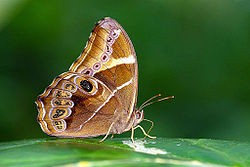| Miller (1968) | | | Harvey (1991) | Peña et al. (2006) |
|---|
| Family | Satyridae | Subfamily | Satyrinae | Satyrinae |
|---|
| Subfamily | Elymniinae | Tribe | Elymniini | Elymniini |
|---|
| Tribe | Elymniini | Subtribe | Elymniiti | |
|---|
| | | |
| Tribe | Lethini | Subtribe | Lethiti |
|---|
| - Aeropetes
- Paralethe
- Enodia
- Lethe
- Neope
- Satyrodes
- Kirinia
- Lasiommata
- Lopinga
- Pararge
- Ethope
- Neorina
| | - Aeropetes
- Paralethe
- Enodia
- Lethe
- Neope
- Satyrodes
- Kirinia
- Lasiommata
- Lopinga
- Pararge
- Ethope
- Neorina
|
| Tribe | Mycalesini | Subtribe | Mycalesiti |
|---|
| - Bicyclus
- Hallelesis
- Henotesia
- Mycalesis
- Orsotriaena
| | - Bicyclus
- Hallelesis
- Henotesia
- Mycalesis
- Orsotriaena
|
| Tribe | Zetherini | Subtribe | Zetheriti |
|---|
| | | |
| Tribe | Zetherini |
|---|
| |
| Subfamily | Biinae | Tribe | Biini | Melanitini |
|---|
| Tribe | Melanitini | Subtribe | Melanititi | |
|---|
| | | |
| Tribe | tribe uncertain | Tribe | tribe uncertain |
|---|
| | | |
| Subfamily | Haeterinae | Tribe | Haeterini | Haeterini |
|---|
| Tribe | Haeterini | | - Cithaerias
- Haetera
- Pierella
- Pseudohaetera
| |
|---|
| - Cithaerias
- Haetera
- Pierella
- Pseudohaetera
|
| Subfamily | Satyrinae | Tribe | Satyrini | Satyrini |
|---|
| | Subtribe | | Parargina |
|---|
| |
| Subtribe | Lethina |
|---|
| |
| Subtribe | Mycalesina |
|---|
| |
| Tribe | Coenonymphini | Subtribe | Coenonymphiti | Coenonymphina |
|---|
| | | | |
| Tribe | Hypocystini | Subtribe | Hypocystiti |
|---|
| - Argyrophenga
- Dodonidia
- Erebiola
- Geitoneura
- Heteronympha
- Hypocysta
- Lamprolenis
- Nesoxenica
- Oreixenica
- Percnodaimon
- Tisiphone
- Zipaetis
| | - Argyrophenga
- Dodonidia
- Erebiola
- Geitoneura
- Heteronympha
- Hypocysta
- Lamprolenis
- Nesoxenica
- Oreixenica
- Percnodaimon
- Tisiphone
- Zipaetis
|
| Tribe | Euptychiini | Subtribe | Euptychiiti | Euptychiina |
|---|
| - Caeruleuptychia
- Cepheuptychia
- Chloreuptychia
- Cissia
- Cyllopsis
- Erichthodes
- Euptychia
- Euptychoides
- Forsterinaria
- Godartiana
- Harjesia
- Hermeuptychia
- Moneuptychia
- Neonympha
- Oressinoma
- Paramacera
- Parataygetis
- Pareuptychia
- Paryphthimoides
- Pharneuptychia
- Pindis
- Posttaygetis
- Oressinoma
- Rareuptychia
- Splendeuptychia
- Taygetis
- Yphthimoides
| | - Caeruleuptychia
- Cepheuptychia
- Chloreuptychia
- Cissia
- Cyllopsis
- Erichthodes
- Euptychia
- Euptychoides
- Forsterinaria
- Godartiana
- Harjesia
- Hermeuptychia
- Moneuptychia
- Neonympha
- Oressinoma
- Paramacera
- Parataygetis
- Pareuptychia
- Paryphthimoides
- Pharneuptychia
- Pindis
- Posttaygetis
- Oressinoma
- Rareuptychia
- Splendeuptychia
- Taygetis
- Yphthimoides
| |
| Tribe | tribe uncertain | Subtribe | subtribe uncertain | subtribe uncertain |
|---|
| | | | |
| Tribe | Ypthimini | Subtribe | Ypthimiti | Ypthimina |
|---|
| - Neocoenyra
- Ypthima
- Ypthimomorpha
| | - Neocoenyra
- Ypthima
- Ypthimomorpha
| |
| Tribe | Melanargiini | Subtribe | Melanargiiti | Melanargiina |
|---|
| | | | |
| Tribe | Maniolini | Subtribe | Manioliti | Maniolina |
|---|
| - Cercyonis
- Hyponephele
- Maniola
- Pyronia
| | - Cercyonis
- Hyponephele
- Maniola
- Pyronia
| |
| Tribe | Pronophilini | Subtribe | Pronophiliti | Pronophilina |
|---|
| - Amphidecta
- Corades
- Daedalma
- Eteona
- Junea
- Lasiophila
- Lymanopoda
- Oxeoschistus
- Panyapedaliodes
- Parapedaliodes
- Pedaliodes
- Praepedaliodes
- Proboscis
- Pronophila
- Pseudomaniola
- Punapedaliodes
- Steremnia
- Steroma
- Idioneurula
- Manerebia
- Argyrophorus
- Quilaphoetosus
- Auca
- Chillanella
- Cosmosatyrus
- Elina
- Etcheverrius
- Nelia
- Pampasatyrus
| | - Amphidecta
- Corades
- Daedalma
- Eteona
- Junea
- Lasiophila
- Lymanopoda
- Oxeoschistus
- Panyapedaliodes
- Parapedaliodes
- Pedaliodes
- Praepedaliodes
- Proboscis
- Pronophila
- Pseudomaniola
- Punapedaliodes
- Steremnia
- Steroma
- Idioneurula
- Manerebia
- Argyrophorus
- Quilaphoetosus
- Auca
- Chillanella
- Cosmosatyrus
- Elina
- Etcheverrius
- Nelia
- Pampasatyrus
| |
| Tribe | Erebiini | Subtribe | Erebiiti | Erebiina |
|---|
| | | | |
| Tribe | Satyrini | Subtribe | Satyriti | Satyrina |
|---|
| - Arethusana
- Berberia
- Brintesia
- Chazara
- Hipparchia
- Karanasa
- Neominois
- Oeneis
- Paralasa
- Pseudochazara
- Satyrus
| | - Arethusana
- Berberia
- Brintesia
- Chazara
- Hipparchia
- Karanasa
- Neominois
- Oeneis
- Paralasa
- Pseudochazara
- Satyrus
| |
| | Tribe | tribe uncertain | |
|---|
| | | | |















